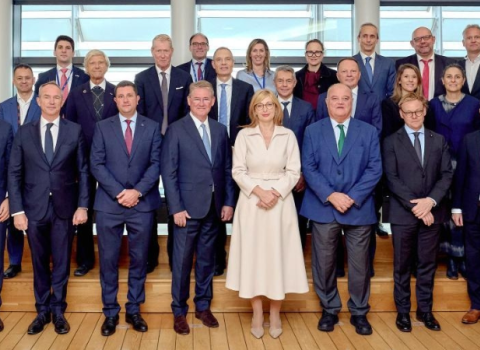
ESADECREAPOLIS, the first international centre devoted to Open Innovation to be associated with a business school.
Its role will be to design the governance model and find the best way to manage the scientists and engineers working on EIT’s InnoEnergy project, which is focused on sustainable energy.
Another duty will be the education and training of InnoEnergy engineers and scientists to shape them into tomorrow’s energy entrepreneurs. Next week the first “From Science to Business” short course to inculcate the entrepreneurial mindset in PhD scientists working on the InnoEnergy project will kick off.
But the Barcelona business school’s interest in researching and promoting innovation goes far beyond its EIT activities. In parallel with the InnoEnergy network, ESADE recently launched ESADECREAPOLIS, the first international centre devoted to Open Innovation to be associated with a business school. The centre, located at ESADE’s Sant Cugat campus, a thriving town near Barcelona, was set up in collaboration with several other public and private entities.
ESADECREAPOLIS, inaugurated in November last year, hosts around 70 companies that are committed to collaborate and exchange ideas, assisted by the in-house Open Innovation expert team. “Our role is to inspire, facilitate and accelerate innovation. An innovation at ESADECREAPOLIS can be a product, a service, or a business model,” Santiago Benedé, the centre’s CEO, told Science|Business. Before joining ESADECREAPOLIS, Benedé was as CEO of one the biggest publishing companies in Spain.
ESADECREAPOLIS expands ESADE’s involvement in innovation from education to being an active innovation agent. “If other universities have built technology parks, the innovation park was the piece of the puzzle we felt was missing for us,” explains Alfons Sauquet, Dean of ESADE’s business school.
To the question why ESADE is so keen to promote innovation, Sauquet says it is because business schools can make a significant contribution. “European society is undergoing a debate where questions such as ‘what do we do with scientific knowledge?’ or ‘how do we transform large investments in R&D into societal benefits?’ are very important. Business schools can help to find answers to those questions.”
It is this principle Sauquet says, that justifies ESADE’s participation in highly risky projects such as InnoEnergy or ESADECREAPOLIS.
Innovation requires a change in behaviour
If ESADECREAPOLIS is the only Open Innovation centre associated with a business school in Europe, it is precisely because this is a very uncertain venture for an academic institution to take on. “Risks in academia are calculated very carefully, but sometimes you have to take the risk,” Sauquet says.
Sauquet defines innovation as a change of behaviour. “This can be produced by a new technology, but also by a change of a business model. When we talk about innovation, there is a part that is science and technology, but there are other ingredients, such as business models.” The fact that this is not widely understood is often an obstacle to innovation.
One of the objectives of ESADECREAPOLIS is to create bridges between the academic community at ESADE and the companies based there. This will be achieved gradually, through practical programmes, testing labs and special innovation programmes. For example, there is already a group, Empresa i Joventut, where MSc students offer advice on business plans to ESADECREAPOLIS companies, under the close guidance of ESADE faculty, in a sort of tutor-supervised consultancy.
ESADECREAPOLIS hosts start-ups, SMEs and innovation departments of big corporations. At the moment it is 60 per cent occupied and all the companies are Spanish. “But we want to go global and internationalise ESADECREAPOLIS; we want to attract foreign companies and be a reference at European level,” Benedé says.
Organisations currently based at ESADECREAPOLIS include the innovation department of Roca, a leading manufacturer of sanitary ware; the pharmaceuticals and chemicals group Esteve; and the Terrassa health care consortium, which is, “In search of a new business model to improve remote care for elderly through the application of telemedicine,” says Elisabet Juan ESADECREAPOLIS senior innovation lead.
In order to foster cross-collaboration, ESADECREAPOLIS organises events, such as get-togethers, to help companies get to know each other, and problem-solving sessions.
Create then appropriate
Of course, intellectual property rights are a delicate part of the innovation process. Here ESADECREAPOLIS follows the slogan for Open Innovation, “First create and then appropriate”. “When we are in the brain storming stage, no-one is the owner of the idea, but at the moment that a project has a leader, then the IP is protected,” explains Juan.
The existence of ESADECREAPOLIS was one of the baits that attracted the father of Open Innovation Henry Chesbrough, to become a visiting professor at ESADE. Chesbrough views the centre as, “A laboratory which gives valuable support to companies and management students in the development of innovative ideas and their application to new business models.”
The hiring of other well-known experts to teach students in executive courses, MBAs, MSc and PhDs is another strategy of the Catalan school to strengthen its innovation arm, says Jonathan Wareham, Research Director of ESADE business school. Other recent hires are Ken Morse, entrepreneur and founding managing director of the MIT Entrepreneur Centre and Wim Vanhaverbeke, Chesbrough’s co-author, from Hasselt University in Belgium, and an expert in ‘low tech’ Open Innovation.
Morse, an expert in sales, was lured to ESADE because he believes it is the business school that understands the innovation process better than any other school in Europe. One visible sign of this, Morse says, is that he asked five different people at ESADE in five different interviews what they wanted him to teach, and all five said, ‘Teach sales, our students need to know how to engage with customers.’ “As far as I know that it’s the only business school that teaches sales, the rest teach marketing,” Morse points out, adding, “Sales and marketing are totally different disciplines and the difference is particularly [important] in start-ups”
“Economic crisis is a wonderful opportunity for entrepreneurship because it’s socially more acceptable to be an entrepreneur,” Morse believes. He says Barcelona is a good place to do business, because it has two excellent business schools, IESE and ESADE that act as talent magnets for students from all over the world, and also because the Catalan government is pretty supportive of innovation.
For Morse, the key issue in getting technology from lab to market is to be in a place where customers pay on time. Then there will be no problem finding venture capital. “If you have a good team, you have world-class customers, then you’ll get the money, but you first need customers, you then raise money.”
In crisis times, says the serial entrepreneur, the government is a venture capitalist with its unemployment subsidies. “This is a great time to start a company: it just takes a passionate entrepreneur to team up with the inventor.”
If Morse is teaching sales, Vanhaverbeke and Chesbrough are teaching open innovation. Just before the summer break, they lectured 78 PhD students working on Open Innovation from all over the world. “Nice technologies exist at universities, one of the biggest problems for innovation is how to go smart with existing technologies and sell them,” says Vanhaverbeke.
Open innovation in business models can help to put this knowledge out in practice. “There is abundance of knowledge, what companies have to make sure is that they don’t only look for ideas inside the company, but also outside the company. This is a big challenge for corporate culture and organisation,” he acknowledges.





 A unique international forum for public research organisations and companies to connect their external engagement with strategic interests around their R&D system.
A unique international forum for public research organisations and companies to connect their external engagement with strategic interests around their R&D system.